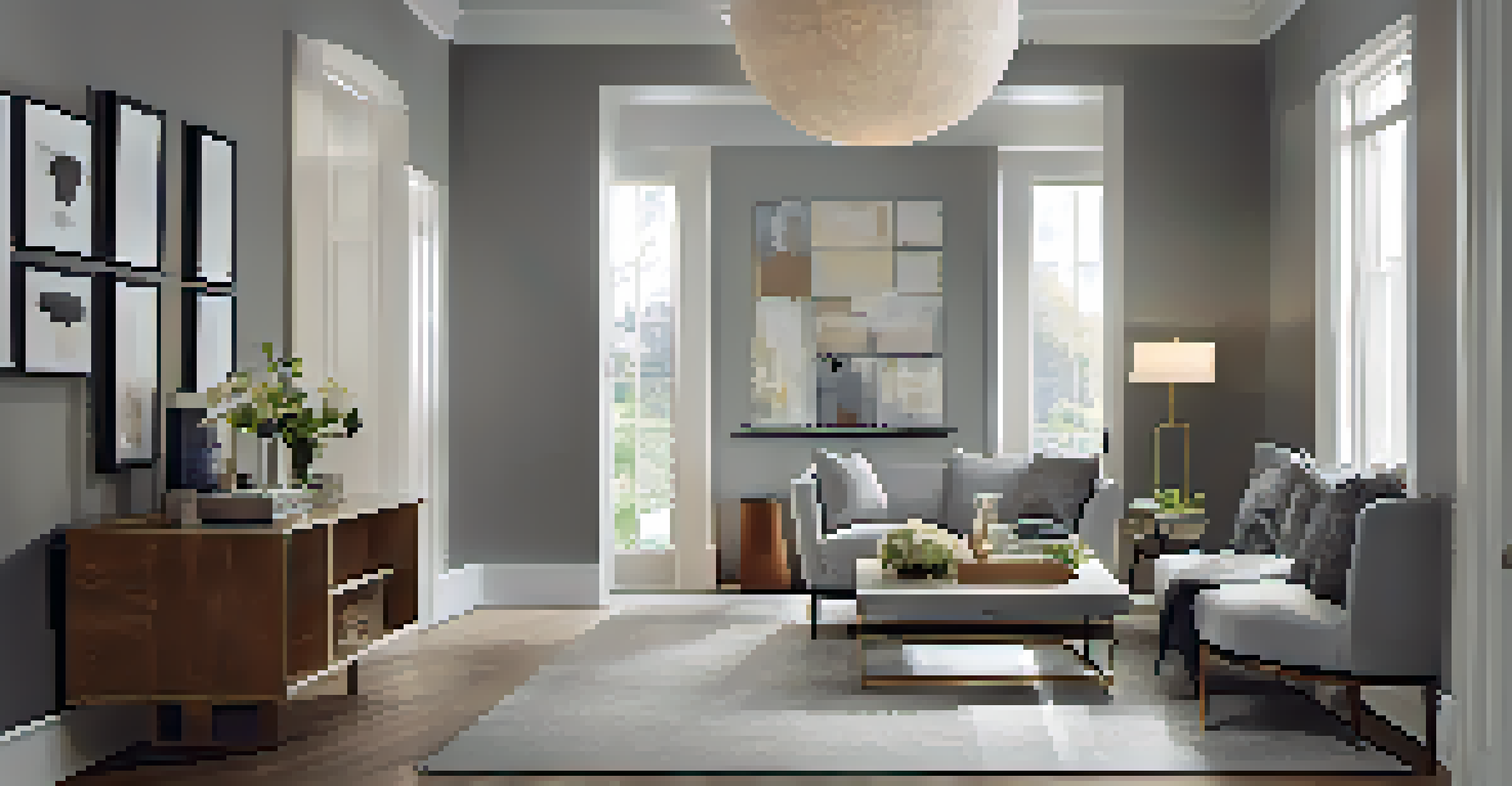The Importance of Lighting in Entryway Design

Creating a Welcoming First Impression with Lighting
The entryway is the first space guests see, making it crucial for setting the tone of your home. Good lighting can create an inviting atmosphere that instantly makes people feel welcome. Imagine walking into a dimly lit area versus a bright, well-lit entryway—there's a stark difference in mood and perception.
Lighting is a powerful tool for creating mood and atmosphere in any space.
Using warm, soft lighting can evoke feelings of comfort and tranquility. Think of how a well-placed chandelier or pendant light can draw the eye and create a focal point. This not only enhances the aesthetic but also welcomes guests with open arms.
Additionally, lighting can highlight architectural features or decor elements, adding depth and interest to your entryway. With the right lighting, even a small space can feel larger and more inviting, transforming the way both residents and visitors experience your home.
Functional Lighting: Safety and Practicality in Design
While aesthetics are essential, functional lighting in entryways also plays a significant role in safety. Adequate lighting ensures that slippery floors, steps, or obstacles are visible, helping to prevent accidents. Imagine coming home late at night; a well-lit entryway allows you to navigate safely without tripping over shoes or bags.

Consider incorporating different layers of lighting, such as ambient, task, and accent lights. Ambient lighting provides overall illumination, while task lighting—like wall sconces or table lamps—can help illuminate specific areas where you might need extra light, such as a console table.
Create Warm Welcoming Lighting
Using soft, warm lighting in your entryway cultivates a cozy atmosphere that instantly makes guests feel welcome.
By thoughtfully planning your lighting, you not only enhance safety but also create a functional space that meets your daily needs. This combination of beauty and practicality is what makes entryway design truly effective.
Choosing the Right Fixtures for Your Entryway
Selecting the right light fixtures is essential for achieving the desired look and feel of your entryway. From chandeliers to wall sconces, each option can drastically change the ambiance. For example, a modern pendant can create a sleek, contemporary vibe, while a vintage lantern adds a touch of charm.
Good lighting can transform a space, making it feel more welcoming and spacious.
When choosing fixtures, consider the size of your entryway. Oversized fixtures in a small space can overwhelm, while too-small fixtures in a large area may feel lost. It's all about balance; the right size will complement your space without overpowering it.
Also, think about the style and finish of the fixtures. Brushed nickel, antique brass, or matte black can all contribute to the overall design theme. Picking fixtures that align with your personal style will help create a cohesive look throughout your home.
Natural Light: Enhancing Entryway Design
Natural light is a game-changer when it comes to entryway design. It not only brightens the space but also connects the indoors with the outdoors. Large windows or glass doors can flood the entryway with sunlight, creating an uplifting and energizing atmosphere.
However, it’s essential to consider how to control that natural light. Window treatments can help diffuse harsh sunlight while still allowing ample light to enter. Sheer curtains, for example, can soften the light while maintaining privacy.
Ensure Safety with Functional Lighting
Incorporating different layers of lighting enhances safety and functionality, preventing accidents in your entryway.
Incorporating mirrors can also amplify natural light, reflecting it throughout the space. This simple design trick can make your entryway feel larger and more open, enhancing the overall welcome experience for anyone who steps inside.
Color Temperature: Setting the Mood with Lighting
The color temperature of your lighting can significantly influence the mood of your entryway. Warm white lights (around 2700K) create a cozy and inviting ambiance, perfect for making guests feel at home. On the other hand, cooler white lights (around 4000K) can evoke a more energetic and modern feel.
Consider the overall aesthetic you want to achieve. For a traditional or rustic entryway, warm lighting will enhance the wood tones and textures. If your style leans more contemporary, cooler lighting may complement sleek surfaces and minimalist decor.
Experimenting with different bulbs can help you find the perfect balance. Dimmable options can also provide versatility, allowing you to adjust the intensity based on the time of day or occasion.
Layering Light for Depth and Interest
Layering light involves combining different types of lighting to create a well-rounded and inviting space. This technique can enhance the overall design and make the entryway feel more dynamic. Think of it as creating a symphony of light—each layer contributes to the whole.
Start with ambient lighting for overall illumination, then add task lighting for functionality, and finish with accent lighting to highlight specific features. This approach not only improves visibility but also adds depth and character to your entryway.
Choose Fixtures that Fit Your Space
Selecting the right size and style of light fixtures is essential for achieving a balanced and cohesive entryway design.
For example, you can use a ceiling fixture for ambient light, table lamps for task light, and wall-mounted spots to showcase artwork or plants. This combination allows your entryway to be both practical and visually appealing.
Sustainable Lighting Choices for Entryway Design
In today's world, sustainability is more important than ever, and that extends to lighting choices as well. Opting for LED lighting not only saves energy but also lasts longer than traditional bulbs. This means fewer replacements and less waste—good for your wallet and the planet.
Consider fixtures made from sustainable materials, such as recycled metals or certified wood. These choices not only help reduce your carbon footprint but also add a unique touch to your entryway design.

Incorporating smart lighting solutions, like motion sensors or programmable systems, can further enhance sustainability. These options allow you to control your lighting based on your needs, ensuring that you only use energy when necessary.